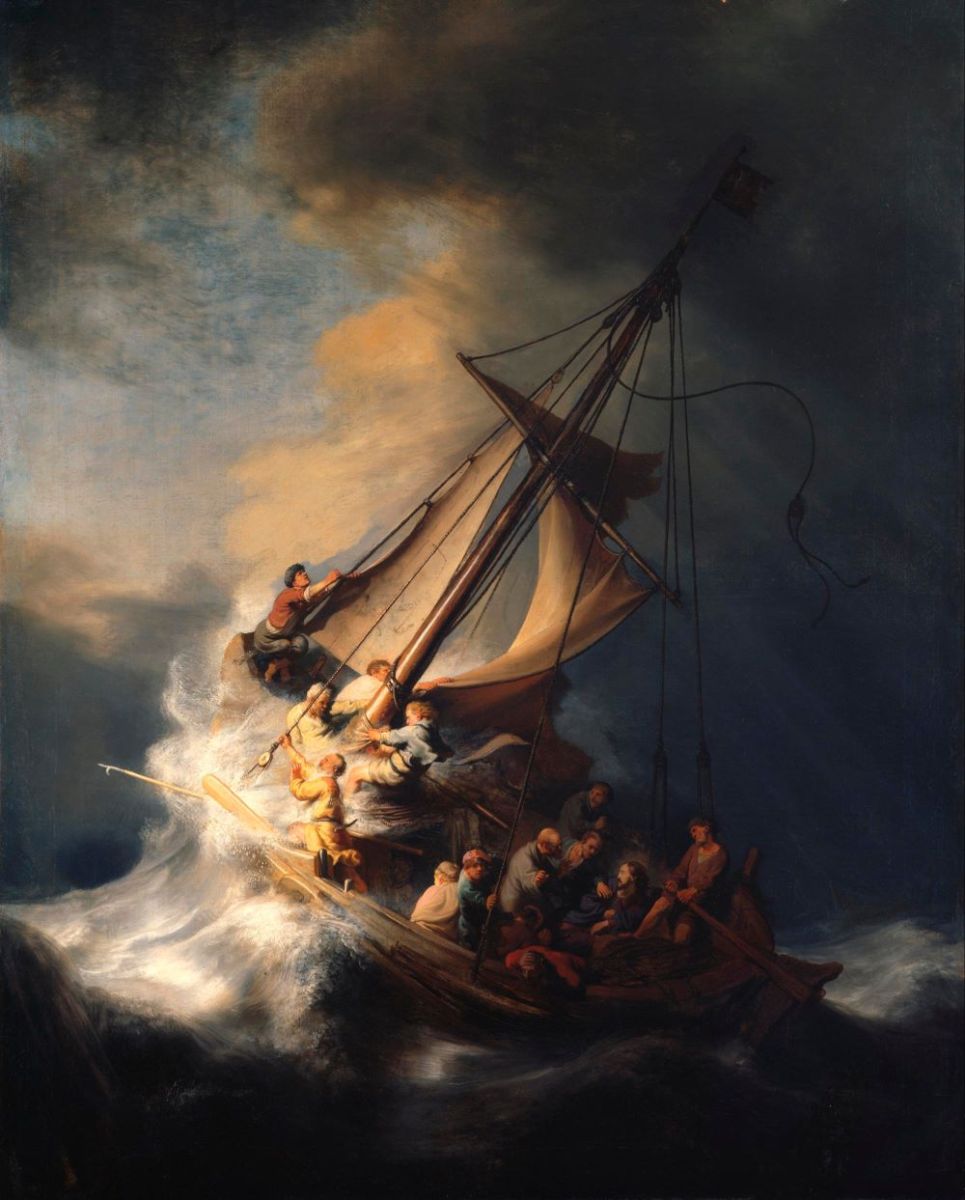Matthew 8 - Rembrandt: Christ in the Storm
Rembrandt van Rijn: Christ in the Storm on the Sea of Galilee

Still Point in the Storm
by Jeff Fountain
Rembrandt’s dramatic painting of Jesus and his disciples caught in a storm on the Sea of Galilee in a Dutch fishing boat contextualised the gospel story for his seventeenth-century viewers.
Still in his mid-twenties when he painted this, his only seascape, soon after moving to Amsterdam from Leiden, Rembrandt depicted fear and desperation in the faces of the disciples who are struggling to prevent their boat from smashing onto the rocks in the left of the picture. The artist’s contrast of light and darkness, his trademark chiaroscuro technique, heightens the sense of impending disaster with the waves and spray breaking over the sides of the vessel tossed by the fierce wind sweeping from left to right across the scene.
While Rembrandt has half the disciples wrestling in their own strength with sails, ropes and tiller, the others are clustered in the shadows, one even throwing up overboard. (See higher resolution image here). Our eye is eventually drawn to the aft of the boat by the lines of harpoon and boom converging on the unperturbed, slightly haloed figure of Jesus. Two agitated disciples demand his attention. The blue figure clutching the rigging, looking straight at the viewer is the artist himself, pulling us into the picture as if to ask, what would you do in such a storm? Struggle desperately, throw up or turn to Jesus?
Those who know the story as told by Matthew (8:23-27), Mark (4:35-41) and Luke (8:22-25), recognise the moment the terror-stricken disciples shake the sleeping Jesus awake, saying, “Master, Master, we’re going to drown!”
Jesus, the still point of the turbulent scenario, rebukes the wind and waves. The storm subsides. Calmness prevails. Awe, wonder and holy fear grip the disciples. “Who is this man?” they ask each other.
This story is part of the unfolding revelation to the disciples of the full identity of their Master, climaxing in the Resurrection and Ascension. ‘This man’ was none other than the Son of God, Lord of creation! That gradual unveiling would radicalise their lives, transform their worldviews and lead to martyrdom for all of the Eleven except John.
How would we contextualise this story today? Storm clouds are hemming us in on each side, it seems. This past summer the UN secretary general warned that the era of global warming had now become the era of global boiling, after scientists confirmed July was the world’s hottest month on record. “Climate change is here. It is terrifying. And it is just the beginning,” he cautioned, aware that the floods, fires and violent weather will disrupt the lives of many millions.
The current blockbuster film Oppenheimer, coupled with Putin’s frequent threats to use nuclear weapons and the urgent warning from over 100 medical journals that the danger is ‘great and growing,’ remind us that the threat of nuclear annihilation did not end with the ‘end’ of the Cold War.
Serious threats to democracy and security come from within our national borders and beyond: foreign interference in elections; disinformation and fake news; physical and cyber threats to democratic institutions; and foreign interference in public office, political parties, and universities. American politics are increasingly polarizing. Unfortunately, what happens in the US has consequences for much of the rest of the world. As does Putin’s misjudged war in Ukraine – already raging for nearly a decade since the annexation of Crimea and showing no signs of just resolution.
Responding to our changing world requires a deeper revelation and understanding of Jesus Christ, not merely as ‘saviour of souls’, but as Lord of history, Lord of the cosmos, God Incarnate, the One through whom and for whom all things were made, and in whom all things hold together (Col. 1:16,17).
In the midst of our storms – whether global or local, universal or personal – we need to bring our anxieties to the One who rebuked the wind and the waves. “Who is this man?” we should constantly ask ourselves. And allow awe, wonder and holy fear to grip our hearts.
*******
Rembrandt van Rijn: Christ in the Storm on the Sea of Galilee, 1633, oil on canvas, 128 x 168 cm. Isabella Stewart Gardener Museum, Boston (stolen and still missing).
First published as a Weekly Word from Jeff Fountain, August 5, 2023. Copyright © 2023 Schuman Centre for Europe Studies, All rights reserved. Schuman Centre for European Studies European Office, Prins Hendrikkade 50a, Amsterdam, Netherlands.
Rembrandt Harmenszoon van Rijn (15 July 1606 – 4 October 1669) was a Dutch painter and engraver. He is generally considered one of the greatest painters and printmakers in European art history and the most important in Dutch history. Having achieved youthful success as a portrait painter, his later years were marked by personal tragedy and financial hardship. Yet his drawings and paintings were popular throughout his lifetime. His reputation as an artist remained high and for twenty years he taught nearly every important Dutch painter. Rembrandt's greatest creative triumphs are exemplified especially in his portraits of his contemporaries, self-portraits, and illustrations of scenes from the Bible. (Biography adapted from https://www.rembrandtonline.org)
Jeff Fountain is director of the Schuman Centre for European Studies (see www.schumancentre.eu) and lives with his wife, Romkje, in Amsterdam, The Netherlands. He writes a weekly e-mail blog in which this article originally appeared. He writes to restore an understanding of the transcendental in European art, culture and history that is so often minimized by reductionist perspectives.
ArtWay Visual Meditation 19 November 2023


